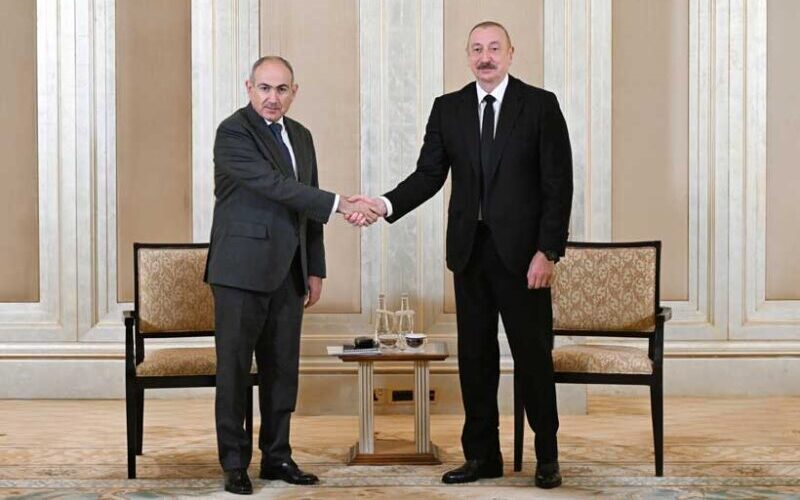Armenia Prime Minister Nikol Pashinyan (L) and Azerbaijan President Ilham Aliyev in Abu Dhabi, UAE, July 10, 2025
Could Azerbaijan and Armenia Weaken Russia’s Influence in the South Caucasus?
The Zanzegur Corridor is only 32 km (20 miles) long, but it has become one of the most important routes in the world.
Connecting Azerbaijan with its Nakhchivan exclave through the Armenian province of Syunik, the corridor connects China with the European Union, passing through Central Asia, the Caucasus, and Türkiye.
But the significance is far more than economic. The Corridor is part of the reconfiguration of the geopolitical balance in the South Caucasus. It is the cornerstone of an ambitious peace process between Armenia and Azerbaijan, based on a strategic opportunity both for the region and globally.
The members of the European Union will have access to strategic hydrocarbons and minerals located in the South Caucasus and Central Asia. The US sees an opportunity to gain influence in a region dominated by Türkiye, Russia, and Iran, consolidating the loss of power of the latter two countries.
An Unprecedented Agreement
The Corridor was established in principle by the 2020 ceasefire agreement signed by Armenia, Azerbaijan, and Russia, with Moscow’s forces providing a guarantee. Diplomatic deadlock and reluctance by both Yerevan and Baku prevented its implementation.
With Nagorno Karabakh finally taken by Azerbaijan from Armenia in 2023, the confirmation of the Corridor became the preference of both countries to secure a peace agreement. The US seized the opportunity to advance the process.
In July 2025, after months of slow-moving negotiations, the US Government offered to manage the Corridor through a long-term lease. The following month, at a summit at the White House, Armenia, Azerbaijan, and the US sealed the multi-faceted agreement.
This included exclusive rights for the US over the development of the Corridor, branded the Trump Route for International Peace and Prosperity to flatter Donald Trump. The route will operate under Armenian law and has been subleased to a consortium, possibly Armenian-American, to develop rail lines, gas and oil transportation, fiber optics, and potentially electrical networks. In this unprecedented model of international public-private cooperation. Armenia has leased the portion of the Corridor in its territory to the US for the next 99 years.
Further eroding Russian and Iranian influence, the US signed Memoranda of Understanding with Armenia and Azerbaijan. Washington will invest in the Azerbaijani energy sector and in infrastructure for regional connectivity and defense, and will develop partnerships in artificial intelligence. Agreements with Armenia include cooperation on border security, which Yerevan had traditionally delegated to Moscow; artificial intelligence; and energy security.
Winners and Losers
For Armenia, putting the Corridor under US administration eases tensions at the expense of relinquishing some territorial control and accepting the supervision of external actors. However, American backing could offer guarantees of sovereignty and stability — a more attractive option than that presented by Russia in 2020 with its perpetual military presence in the Corridor.
Implementation of the Corridor will represent a de facto unblocking of communications, as Armenia’s borders with Türkiye and Azerbaijan are currently closed. With the deterioration of Armenian-Russian relations, Iran had been Yerevan’s only regional partner.
For Azerbaijan and its strategic ally Türkiye, the Corridor is an opportunity to extend commercial influence in Europe and Central Asia. A new logistics route is aligned with projects such as the Middle Corridor initiative and the expansion of regional trade.
For the major powers, the launch of the Corridor by an American-led consortium confirms the emergence of a new player in the region. The Memoranda of Understanding complement the hydrocarbons market through an agreement between Exxon Mobil and the Azerbaijani state-owned company SOCAR.
In contrast, Russia’s influence is reduced, continuing a trend since September 2023 after Azerbaijan’s reclaiming of Nagorno-Karabakh. Armenia begun a shift towards the West, moving closer to France and partially distancing itself from Moscow. Relations between Azerbaijan and Russia are at their most tenuous since the dissolution of the USSR, marked by arrests in both countries and the closure of Rossotrudnichevsto — one of Russia’s primary tools for soft power — in Baku last February.
Iran, whose only significant partner in the region was Armenia, risks being diminished as it loses influence in Yerevan to Washington. On August 19, Iranian President Masoud Pazershkian tried to check the decline with an official visit to Armenia to try to establish a new strategy following the US move. The two countries signed a Memorandum of Understanding on infrastructure cooperation, agreeing to strengthen connectivity by increasing the capacity of the Norduz Bridge and building a second connection.
The New Framework for Peace
The August summit in the White House resolved two issues: the unblocking of communications between Azerbaijan and the exclave of Nakhchivan, via the Zanzegur Corridor and the dissolution of the OSCE’s Minsk Group, created in 1992 to mediate the conflict, a condition set by Azerbaijan.
Despite US intervention, the peace process remains essentially bilateral. However, the trilateral agreement and the commitments with Washington have laid the groundwork for the US to invest in infrastructure in both nations. The eventual start of trade cooperation between the two countries with US assistance — “Trade Will Bring Peace” — highlights economic interdependence as a stabilizer of the situation between the two countries.
One fundamental issue must be resolved before the peace treaty can be signed: changes to the Armenian Constitution. Azerbaijan is demanding amendment of the Preamble, which refers to a 1989 law on the unification of Armenia and Karabakh. The Armenian Government announced a referendum in 2026 for Constitutional change, albeit with no details on specific points.
What’s At Stake
The Washington Agreement and the Zanzegur Corridor are a structural change in the balance of power in the South Caucasus. The entry of the US as the guarantor of the project pushes aside Russia and creates a new framework of alliances for commercial, energy, and geopolitical interests.
The Corridor is shaping up to be more than a transit route: it is a platform for cooperation that, if well managed, can foster economic interdependence, diversify Eurasian trade routes, and open up new spaces for dialogue between Armenia, Azerbaijan, and Türkiye.
However, its success will depend on the ability of the actors involved to overcome historical mistrust while ensuring the security of the corridor and maintaining political commitment beyond the initial signing of the Agreement.
The final resolution of the conflict requires internal reforms in Armenia, sustained commitments from Azerbaijan, and a careful balance between sovereignty and openness to international cooperation.
If this is achieved, the Corridor will be an engine of regional integration rather than a new source of friction. It might even a symbol of reconciliation and a turning point for stability.


In that case I doubt there will still be a country named Armenia with in mount Ararad and a Christian ✝️ Nation.